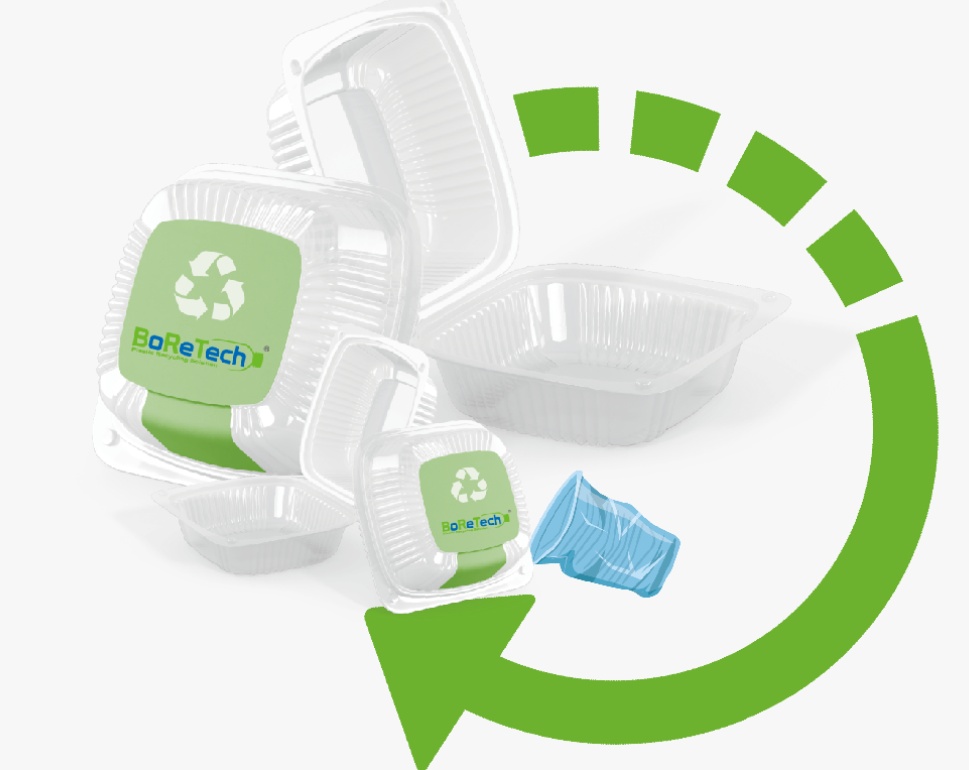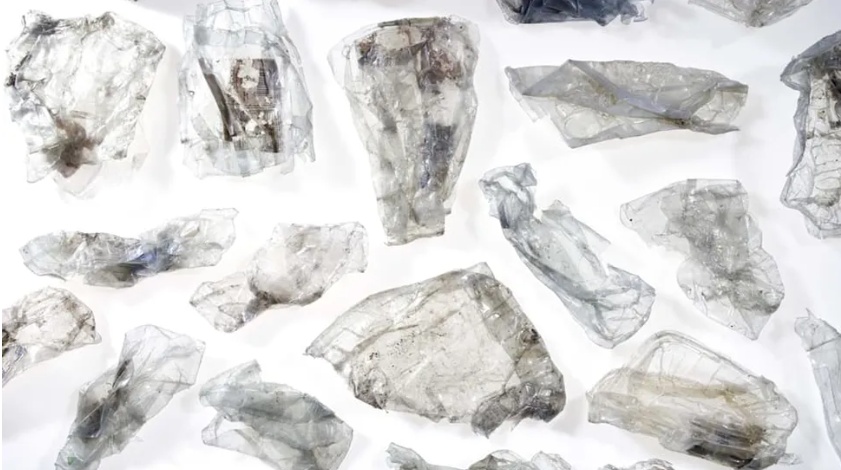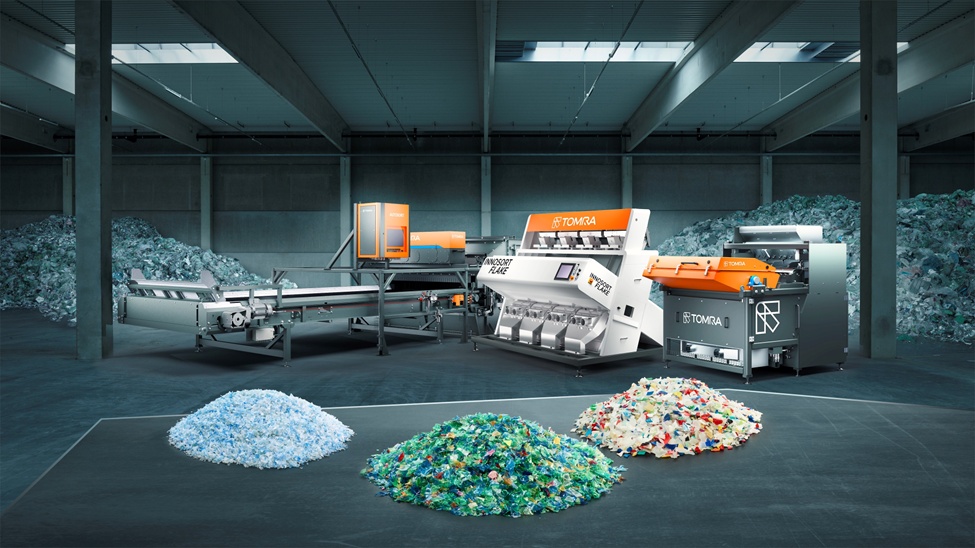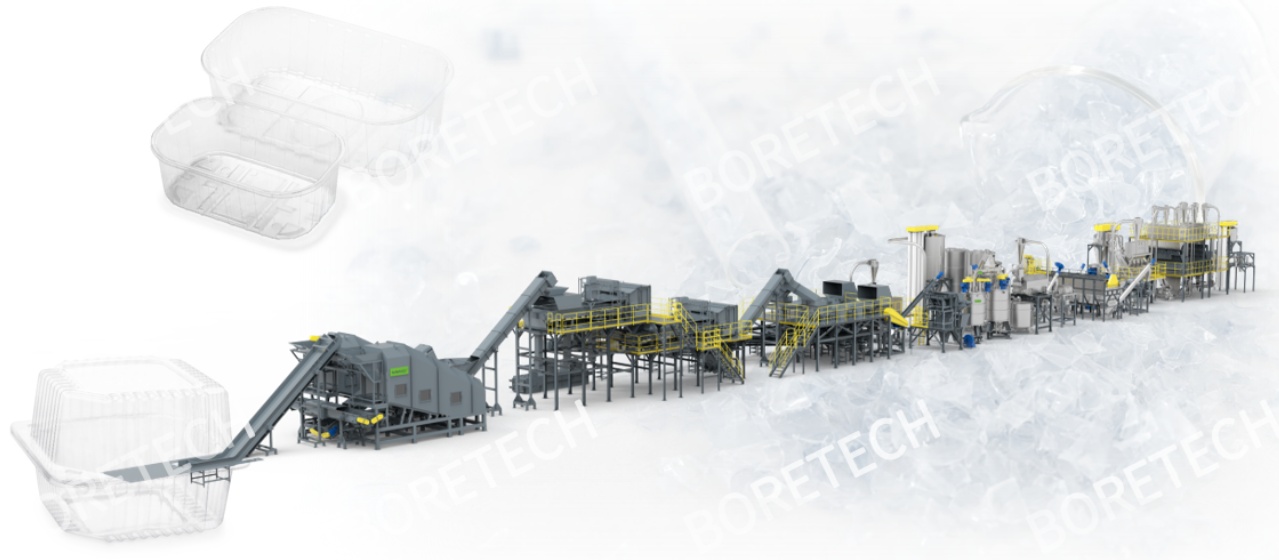70% Incinerated or Landfilled! From Mixed Use to Dedicated Use, PET Tray Closed-Loop Recycling Enters Boom Period
In the global landscape of the plastic circular economy, the recycling system for PET bottles is relatively mature, while PET trays (or clamshells) have long been neglected as an "environmental lowland." Data shows that the EU consumes approximately 1 million tons of PET trays annually, which are widely used in packaging for fresh produce, prepared foods, takeaways, and other food sectors. However, as much as 70% of these trays are ultimately incinerated or landfilled, with only 300,000 tons being effectively recycled.
More severe is the fact that even among the few pallets using recycled materials, the raw materials mostly come from recycled PET bottles. This "bottle-pallet mixed use" model not only intensifies the competition for bottle-grade recycled materials but also deviates from the original intention of a closed-loop recycling system of "bottle for bottle, pallet for pallet." With policies such as the EU Packaging and Packaging Waste Regulation (PPWR) mandating higher recycled content in non-bottle packaging, the establishment of a dedicated pallet recycling system has shifted from an "optional" to a "mandatory" choice. Moreover, alongside the rapid development of domestic and international e-commerce, the resulting plastic pollution problems have become increasingly prominent. The stark contrast between the vast recycling potential and the severe reality is driving the positive development trend of tray-to-tray closed-loop recycling!

Source: Baolvt
1. PETTray recycling faces four major core challenges, and the industry urgently needs breakthrough solutions.
In the context of the rapid development of the global plastic circular economy, the recycling and reuse of PET pallets face more complex systemic challenges compared to PET bottles. According to related reports summarized by Zhuansu Shijie, the current recycling of PET pallets is mainly constrained by four core challenges, and these bottlenecks urgently require technological innovation and policy support to overcome.
1 Structural complexity is the primary obstacle.
The PET trays widely used in modern food packaging often adopt a multi-layer composite structure, such as PET/PE/EVOH and other multi-material combinations, supplemented with dark ink printing and adhesive labels. Although this composite design meets the functional requirements of packaging, it brings significant challenges to subsequent sorting and cleaning processes. What is even more troublesome is the current market situation where single-layer and multi-layer trays circulate mixed together, further reducing the purity of recycled raw materials and directly affecting the quality of recycled products.
2 Morphological diversity challenges sorting technology
Unlike standardized PET bottles, tray products exhibit significant differences in shape, thickness, color, and other aspects. From transparent fresh food packaging boxes to black microwave meal boxes, this diversity in form poses extremely high compatibility requirements for automated sorting equipment. Currently, sorting systems on the market often struggle to efficiently recognize different types of trays simultaneously, resulting in difficulties in improving sorting efficiency and accuracy.
3 Pollution issues restrict the quality of regeneration.
Used PET trays generally suffer from severe contamination issues, including food residues, label remnants, and cross-contamination generated during compression and packaging processes. Particularly in China's takeout industry, grease penetration is especially prominent, often requiring additional chemical cleaning procedures. These contamination factors make it difficult for recycled materials to meet food-grade standards, limiting the possibility of high-value recycling utilization.
4 The lack of a recycling system hinders large-scale development.
Compared to the mature recycling network for PET bottles, a dedicated recycling system for trays remains largely nonexistent in most regions. Currently, discarded trays are often mixed with low-value plastic waste for processing, leading to resource wastage. Even in the EU, which leads in environmental policies, only a few countries such as France and Belgium have established dedicated tray collection and data statistics systems. This systemic deficiency severely restricts the large-scale development of the entire industry.

PET trays typically have complex designs and compositions, making sorting and decontamination challenging (Image source: Recycled PET New Vision).
To solve these challenges, collaborative innovation across the upstream and downstream of the industry chain is needed, while the government should accelerate the improvement of related recycling policies and infrastructure construction. Only with concerted efforts from multiple parties can the PET tray recycling industry overcome bottlenecks and achieve sustainable development.
2. European PETPallet Recycling Practices: Driven by Both Policy and Technology
As a global pioneer in the field of environmental protection, the European Union is accelerating the construction of a PET tray recycling system through strong policy guidance and the application of cutting-edge technology.
At the policy level, the European Union has introduced a series of regulations in recent years to set clear targets for the recycling of PET pallets. Among them, the Single-Use Plastics Directive (SUPD) is the first to include non-bottle packaging within its regulatory scope, requiring companies to increase the proportion of recycled materials used. The more binding Packaging and Packaging Waste Regulation (PPWR) further stipulates that by 2030, the recycled content in PET food contact packaging must reach 30%, and at the same time, pallets must have a recyclability rate exceeding 70% to enter the market. These policies not only provide the industry with a clear development path but also compel companies to accelerate technological upgrades and the construction of recycling systems.
In terms of technological applications, European companies have taken the lead in establishing a full-chain solution from sorting to recycling. For example, Tesco and Hilton Foods have collaborated to launch food trays in the UK made entirely from recycled PET. This pilot project will highlight Tesco Finest minced beef products in Kp's tray-to-tray (T2T) packaging, which contains 30% recycled content.
Meanwhile, European countries are also actively exploring collaborative models for the industrial chain. France and Belgium have taken the lead in piloting Deposit Return Schemes (DRS), encouraging consumers to return used PET trays and improving collection efficiency through dedicated recycling channels. In addition, the European Committee for Standardization (CEN) is leading the development of “Design for Recycling” (DfR) standards for plastic packaging, promoting companies to reduce the use of multi-layer composite materials and enhancing recyclability at the source.
Technological innovation breakthrough in PETBottleneck in tray recycling
Faced with the complex challenges of PET tray recycling, global companies are advancing the industry toward large-scale application through three major technological approaches: intelligent sorting, efficient cleaning, and material innovation.
In the sorting stage, multi-sensor fusion technology has become the mainstream solution. For instance, recycling technology companies like TOMRA are significantly enhancing the efficiency and purity of pallet recycling through intelligent sorting systems that utilize multi-sensor fusion. This system achieves efficient recycling in two steps: the first step uses the AUTOSORT™ sorter, which employs near-infrared technology to accurately distinguish between single-layer and multi-layer PET pallets before crushing. Single-layer pallets are key to high-quality closed-loop recycling, ensuring material quality from the source. The second step involves crushing the pallets into flakes, which are then sorted at high speed by INNOSORT™ FLAKE to remove opaque PET, PVC, metals, and other impurities. Subsequently, AUTOSORT™ FLAKE detects material aging, trace metals, and multi-layer structures, providing dual-layer precision. Through multiple intelligent sorting processes, the purity of the recycled PET flakes reaches over 99%, fully meeting the stringent requirements for food-contact packaging, thus providing strong support for closed-loop recycling of PET pallets.

Through multiple stages of refined intelligent sorting, the purity of recycled PET flakes can reach over 99%, fully meeting the stringent requirements for food contact packaging. (Image source: TOMRA Recycling)
The breakthrough in cleaning technology is equally critical. China Baogreentech Co., Ltd. has developed a PET tray cleaning system that uses pulse hot washing technology and label wind selection technology, successfully increasing the removal rate of adhesive labels to over 90% and the separation rate of film labels to over 99%. This technological breakthrough effectively solves the problem of label residue in traditional cleaning processes. It is reported that Baogreentech's demonstration plant, with an annual processing capacity of 25,000 tons, will officially start operations in November 2025, providing a replicable technical model for the industry.

Source: Baolute
Material innovation is a fundamental approach to reducing recycling difficulty from the source. More and more companies are promoting PET pallets designed with a single material to avoid using multilayer composite structures that are difficult to separate. In addition, the widespread adoption of biodegradable labels has significantly reduced energy consumption during the cleaning process—labels using water-soluble adhesives are easier to remove during cleaning, further improving the purity and cost-effectiveness of recycled materials.
Driven by both policy and technology, PET tray recycling is moving from pilot projects to large-scale applications, opening new growth opportunities for the global plastic circular economy.
Editor: Lily
Sources: Recycled PET New Vision, Petco | Committed to PET Circular Development, TOMRA, Polygreen, Sustainable Plastics, etc.
【Copyright and Disclaimer】This article is the property of PlastMatch. For business cooperation, media interviews, article reprints, or suggestions, please call the PlastMatch customer service hotline at +86-18030158354 or via email at service@zhuansushijie.com. The information and data provided by PlastMatch are for reference only and do not constitute direct advice for client decision-making. Any decisions made by clients based on such information and data, and all resulting direct or indirect losses and legal consequences, shall be borne by the clients themselves and are unrelated to PlastMatch. Unauthorized reprinting is strictly prohibited.
Most Popular
-

EVA Morning Prices on September 12: Most of the Market Holds Steady, Highest Rise of 50 Yuan
-

Domo Chemicals Files for Bankruptcy Protection in Germany! B. Braun Launches New Supply Assurance Program
-

Vynova's UK Chlor-Alkali Business Enters Bankruptcy Administration!
-

[PET Weekly Outlook] Polyester Bottle Chips Expected to Oscillate and Warm Up with Costs Today
-

Case Study | Clariant AddWorks™ Additives Solve Plastic Yellowing Problem






